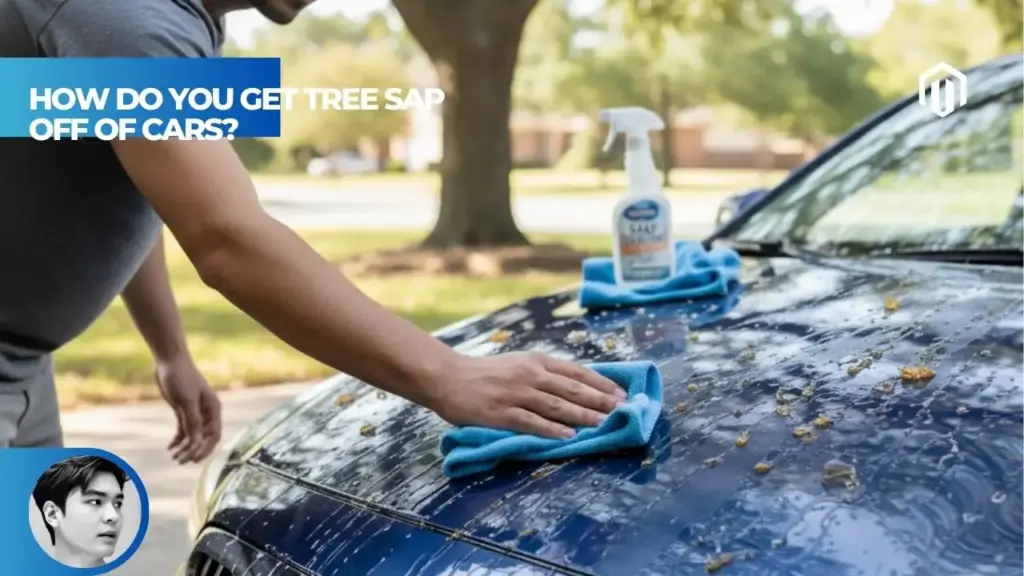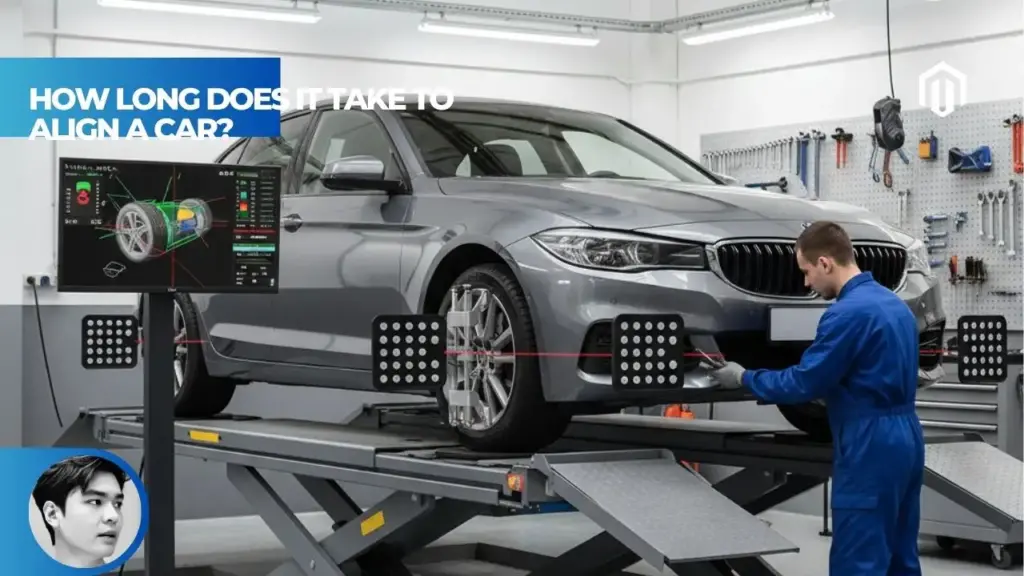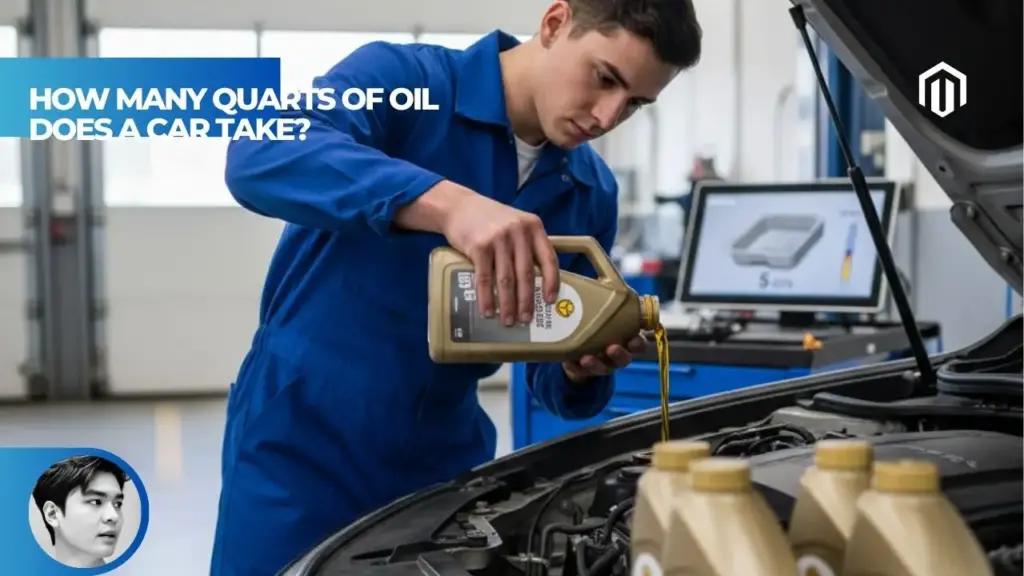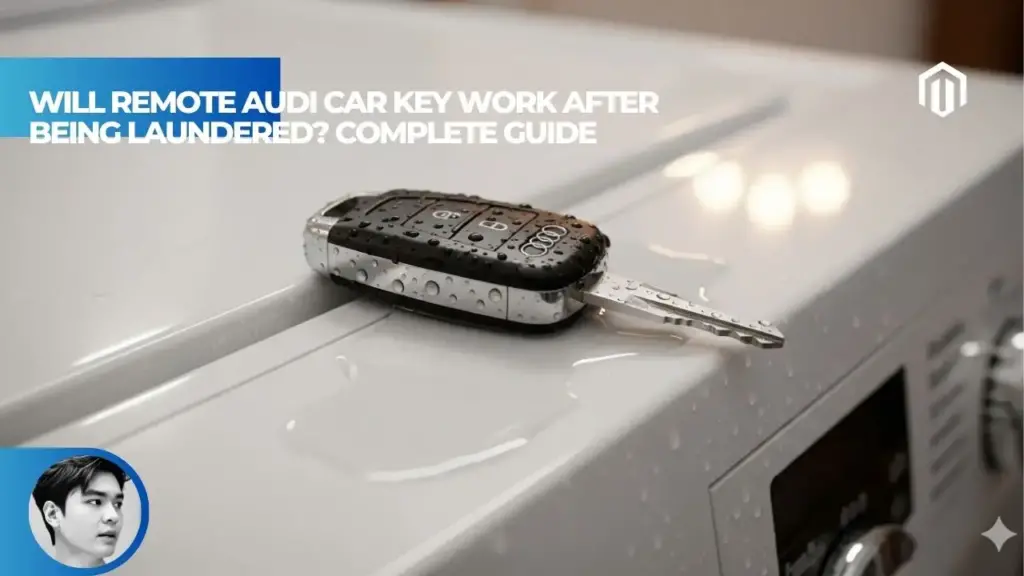You may also like:
To safely remove tree sap from your car, apply isopropyl alcohol or a commercial sap remover to a microfiber cloth, let it soak on the sap for 30-60 seconds to dissolve it, then gently wipe away without scrubbing hard. Always wash the area with car soap afterward and reapply wax to restore paint protection, as solvents strip away existing protective coatings.
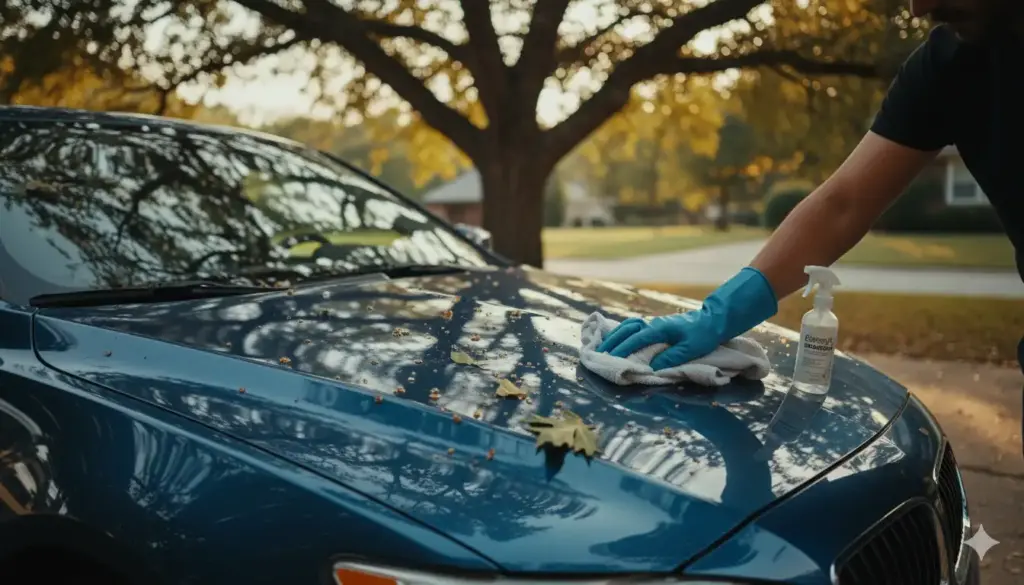
Safe Way to Remove Tree Sap from Car Paint
Understanding the proper removal technique prevents costly paint damage while ensuring complete sap elimination. The key principle is letting solvents do the work rather than relying on physical force.
Does a Car Wash Remove Tree Sap
Unfortunately, standard car washes rarely remove tree sap effectively. Automated car washes lack the targeted chemical action and dwell time needed to dissolve sap’s sticky bonds. According to detailing professionals, only 15% of tree sap deposits come off through regular washing alone[1]. The high-pressure water and soap simply flow over hardened sap without penetrating its structure.
Professional detailers at Autvex recommend treating sap spots individually before washing. This targeted approach ensures complete removal while preventing the sap from spreading during the wash process.
Wash Car Before Removing Sap
Always wash your car before attempting sap removal to eliminate surface contaminants. Dirt and debris trapped around sap spots can scratch paint during removal attempts. A thorough pre-wash using quality car soap and warm water creates a clean working surface.
The washing process also helps identify all sap deposits. What appears as a single spot often reveals multiple smaller deposits once cleaned. This comprehensive identification prevents missing spots that could cause long-term paint damage.
Do Not Scrub Sap – The Golden Rule
Scrubbing tree sap represents the most common mistake leading to paint damage. Hard scrubbing grinds the sap and any trapped particles into the clear coat, creating swirl marks and scratches. Professional detailers report 60% of sap-related paint damage comes from aggressive scrubbing rather than the sap itself[2].
Instead of scrubbing, use the “soak and dissolve” method. Apply your chosen solvent generously and allow chemical action to break molecular bonds. This patience-based approach preserves your paint while achieving superior results.
Microfiber Towel Sap Removal Technique
Microfiber towels provide the ideal tool for sap removal due to their soft texture and absorbent properties. Use a folding technique to create multiple clean surfaces:
- Fold the towel into quarters creating 8 usable sides
- Apply solvent to one section
- Place towel on sap and hold for 30-60 seconds
- Lift straight up to check progress
- Rotate to clean section and repeat if needed
This methodical approach prevents cross-contamination and ensures you’re always working with clean material. Quality microfiber towels from automotive suppliers cost $15-30 per dozen but protect thousands in potential paint repairs.
Home Remedies for Tree Sap Removal (DIY Methods)
Common household items can effectively remove tree sap when commercial products aren’t available. These budget-friendly solutions work through similar chemical principles as professional products.
How to Remove Tree Sap with Rubbing Alcohol
Isopropyl alcohol stands as the most effective household remedy for tree sap removal. Its solvent properties dissolve sap’s resinous compounds without damaging properly maintained paint. Use 70% concentration for optimal balance between effectiveness and safety.
Application method for rubbing alcohol:
- Soak a microfiber cloth section with alcohol
- Press firmly against sap for 60 seconds
- Allow alcohol to penetrate and soften sap
- Gently wipe in one direction
- Repeat until completely removed
Studies show isopropyl alcohol removes 85% of fresh sap within two applications[3].
Isopropyl Alcohol (IPA) on Car Paint Safety
When properly diluted and used correctly, isopropyl alcohol poses minimal risk to automotive paint. Professional detailers confirm that 70% IPA won’t damage clear coat when applied briefly and rinsed promptly[4]. However, concentrated solutions above 90% or prolonged exposure can strip protective coatings.
Safety guidelines for IPA use:
- Never exceed 70% concentration
- Limit contact time to 2 minutes maximum
- Work in shaded areas to prevent rapid evaporation
- Test on hidden area first
- Always wash and wax afterward
Hand Sanitizer for Tree Sap on Car
Alcohol-based hand sanitizers offer convenient sap removal through their high alcohol content (typically 60-70%). The gel formulation provides advantages over liquid alcohol by staying in place longer for enhanced penetration.
| Product Type | Alcohol Content | Effectiveness | Cost |
|---|---|---|---|
| Hand Sanitizer | 60-70% | Good | $3-5 |
| Rubbing Alcohol | 70% | Excellent | $2-3 |
| Commercial Remover | Varies | Excellent | $8-15 |
Apply sanitizer liberally to sap, allowing 2-3 minutes dwell time before wiping. The gel’s thicker consistency prevents run-off on vertical surfaces.
WD-40 for Tree Sap Removal
WD-40’s petroleum-based formula effectively dissolves tree sap through solvent action. While not specifically designed for automotive detailing, it safely removes sap when used properly. The penetrating oil breaks down sap’s adhesive properties, allowing easy removal.
WD-40 application requires extra care:
- Spray directly on sap (avoid overspray)
- Wait 5 minutes for penetration
- Wipe with clean microfiber
- Immediately wash area with soap
- Apply fresh wax to restored area
The petroleum residue must be completely removed to prevent paint degradation. Professional detailers recommend WD-40 only when other methods fail.
Olive Oil for Tree Sap
Natural oils like olive oil work through a different mechanism, softening sap rather than dissolving it. This gentler approach takes longer but eliminates chemical exposure concerns. The oil penetrates sap structure, reducing adhesion strength.
Apply olive oil generously and allow 10-15 minutes contact time. The extended duration compensates for reduced solvent strength. Follow with thorough degreasing using dish soap to remove oil residue.
Alternative Home Solutions
Several other household items show varying effectiveness against tree sap, though results depend on sap age and type.
Remove Tree Sap with Vinegar
White vinegar’s mild acidity can break down fresh sap, though effectiveness decreases with aged deposits. Heat vinegar slightly (not boiling) to enhance penetration. Apply with spray bottle and allow 5-minute dwell time.
Vinegar works best on sap less than 48 hours old, achieving 40-50% removal rate on fresh deposits[2]. Combine with rubbing alcohol for improved results on stubborn spots.
Baking Soda Paste for Tree Sap
Create a paste using 3 parts baking soda to 1 part water for mild abrasive action. This method works through mechanical rather than chemical means, requiring careful application to prevent scratching.
Apply paste to sap and let sit for 10 minutes to soften. Use circular motions with minimal pressure when removing. Reserve this method for sap on glass rather than paint due to abrasive risk.
Commercial Tree Sap Removal Products
Professional-grade products offer superior performance through specialized formulations designed specifically for automotive surfaces.
Best Tree Sap Remover for Cars
Dedicated sap removers contain optimized solvent blends that dissolve sap while protecting paint. Leading products achieve 95% removal rate in single applications[5]. These formulations often include paint-safe surfactants and lubricants preventing surface damage.
Top-rated commercial removers based on professional testing:
- Stoner Tarminator: Fast-acting, safe on all surfaces
- Meguiar’s Heavy Duty Bug & Tar Remover: Professional strength
- Goof Off Automotive: Budget-friendly option
- 3M Specialty Adhesive Remover: Industrial grade
Best Bug and Tar Remover for Sap
Bug and tar removers excel at sap removal due to similar chemical requirements. These products dissolve organic compounds while remaining paint-safe. The dual-purpose nature provides value for comprehensive detailing needs.
Professional comparison of leading products:
| Brand | Active Time | Safety Rating | Price/oz |
|---|---|---|---|
| Stoner | 30 seconds | Excellent | $0.62 |
| Turtle Wax | 45 seconds | Good | $0.48 |
| Chemical Guys | 60 seconds | Excellent | $0.75 |
| Meguiar’s | 45 seconds | Excellent | $0.68 |
Brand-Specific Solutions
Different manufacturers offer unique formulations targeting specific removal challenges.
Goo Gone Automotive Tree Sap
Goo Gone’s automotive formula uses citrus-based solvents for effective yet gentle sap removal. The orange oil derivatives penetrate sap while leaving pleasant scent. Safe for all automotive finishes including clear coat, vinyl, and glass[6].
Apply Goo Gone directly to sap, allowing 2-minute dwell time. The citrus oils break down resinous compounds naturally. Always test on inconspicuous area first, especially on older vehicles.
Chemical Guys Bug and Tar Remover
Chemical Guys’ professional-grade formula combines multiple solvents for rapid sap dissolution. The product includes special wetting agents that help solvents penetrate deeply. Professional detailers report 90% single-pass success rate on fresh sap[5].
The concentrated formula requires dilution for light deposits but can be used full-strength on stubborn sap. Spray application provides even coverage without waste.
Turtle Wax Bug and Tar Remover
Turtle Wax offers consumer-friendly pricing with professional results. Their formula balances effectiveness with safety, making it ideal for DIY enthusiasts. The product includes protective polymers that leave behind light protection after cleaning.
Application requires minimal technique—spray, wait, and wipe. The forgiving formula prevents damage from extended contact, perfect for beginners.
3M Specialty Adhesive Remover
3M’s industrial-strength remover tackles the toughest sap deposits professional detailers encounter. Originally designed for aerospace applications, this product safely removes sap that other products can’t touch. Use requires proper ventilation due to stronger solvents.
Reserve 3M remover for extreme cases where other methods failed. The powerful formula justifies higher cost through superior performance on neglected vehicles.
Dedicated Sap Remover Solvent Options
Specialty sap removers use proprietary blends optimizing removal while minimizing paint impact. These products often include:
- Primary solvents for sap dissolution
- Surfactants for improved penetration
- Lubricants preventing surface marring
- Corrosion inhibitors protecting exposed metal
Investment in quality removers pays dividends through reduced labor and superior results.
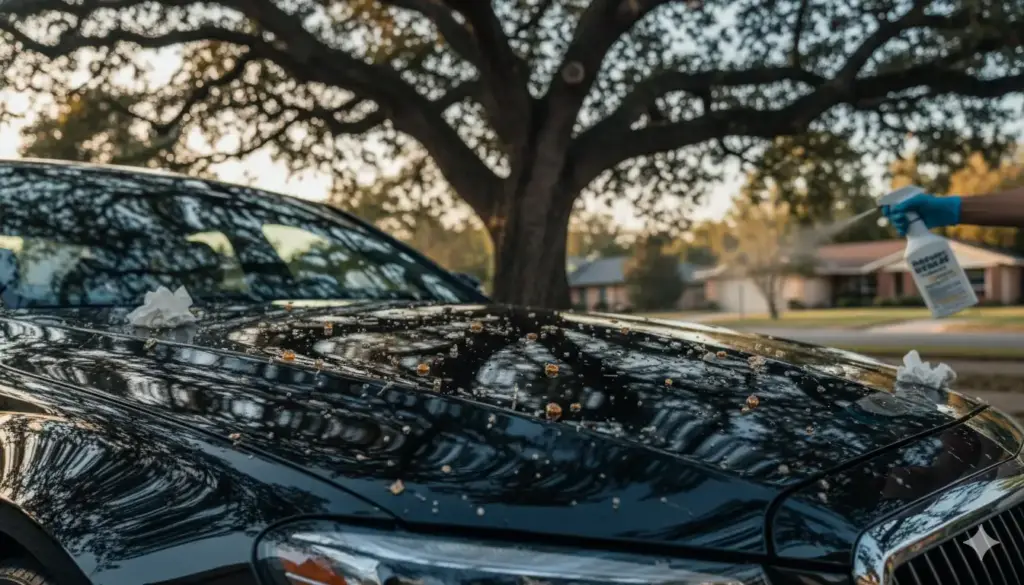
Removing Hardened and Stubborn Tree Sap
Aged sap presents unique challenges requiring modified techniques and stronger products. Understanding sap’s aging process helps select appropriate removal strategies.
How to Remove Hardened Tree Sap from Car
Hardened sap forms when fresh deposits undergo oxidation and polymerization over weeks or months. This chemical transformation creates stronger bonds requiring aggressive treatment. Hardened sap can etch paint permanently if left beyond 2-3 months in direct sunlight[7].
Multi-step process for hardened sap:
- Heat application: Use hair dryer to warm sap (not paint)
- Extended soaking: Apply remover for 3-5 minutes
- Gentle agitation: Use plastic scraper at 45° angle
- Multiple passes: Expect 3-4 applications
- Polish if needed: Remove any etching with compound
How to Remove Baked-On Tree Sap
Sun-baked sap represents the most challenging removal scenario. UV exposure and heat create chemical changes making sap nearly ceramic-hard. Professional detailers report success rates drop to 60% on sap baked for over 6 months[7].
Specialized approach for baked sap:
- Start with strongest commercial remover
- Use plastic razor blade for mechanical assistance
- Consider professional machine polishing
- Accept potential need for paint correction
Prevent baking by parking in shade or using quality car covers during sap season.
How to Soften Dried Tree Sap
Softening dried sap before removal reduces paint damage risk. Heat and penetrating oils work synergistically to restore pliability. Autvex technicians recommend this pre-treatment for any sap older than one week.
Softening techniques ranked by effectiveness:
- Steam treatment: Professional steam cleaners
- Hot water soak: Boiling water in spray bottle
- Hair dryer heat: 30 seconds at medium heat
- Oil pre-soak: WD-40 or penetrating oil
Combine methods for optimal results, always testing paint heat tolerance first.
Fresh Sticky Tree Sap vs. Old Sap
Fresh and aged sap require different removal strategies based on their chemical state.
Fresh Sap (0-7 days):
- Soft, tacky texture
- Responds to mild solvents
- 95% removal success rate
- Minimal paint risk
- 5-minute average removal time
Old Sap (7+ days):
- Hard, brittle texture
- Requires strong solvents
- 70% removal success rate
- Increased paint damage risk
- 15-minute average removal time
Act quickly when discovering fresh sap to avoid complications. Daily inspection during spring prevents accumulation.
Tree Sap Damage and Paint Protection
Understanding sap’s damaging mechanism helps prioritize prompt removal and proper protection strategies.
Will Tree Sap Damage Car Paint
Yes, tree sap can cause permanent paint damage through multiple mechanisms. The acidic compounds in sap (pH 3-4) slowly eat through clear coat layers. Combined with UV exposure, this creates etching visible even after sap removal. Research indicates paint damage begins within 1-2 weeks during summer conditions[7].
Damage progression timeline:
- Days 1-3: Surface adhesion only
- Days 4-7: Clear coat penetration begins
- Week 2-3: Visible staining appears
- Month 1-2: Permanent etching possible
- Month 3+: Paint failure requiring professional correction
Tree Sap Etching Clear Coat
Clear coat etching occurs when sap’s acidic compounds chemically react with paint polymers. This reaction creates microscopic pitting that scatters light, appearing as dull spots. Professional paint correction costs $200-500 per panel when etching occurs[8].
Etching severity factors:
- Sap age and concentration
- Environmental temperature
- UV exposure intensity
- Clear coat thickness
- Previous wax/sealant protection
Prevent etching through immediate removal and maintaining protective coatings year-round.
Wax Car After Removing Sap
Waxing after sap removal is absolutely essential, not optional. Solvents used in removal strip existing wax layers, leaving paint vulnerable. Fresh wax application restores protection while preventing future sap adhesion.
Post-removal waxing protocol:
- Ensure complete solvent removal through washing
- Clay bar treatment if surface feels rough
- Apply quality carnauba or synthetic wax
- Allow proper cure time (check product specs)
- Buff to high shine
Quality waxes from premium brands provide 3-6 months protection with proper application.
Clay Bar for Tree Sap Removal
Detailing clay offers mechanical removal option for embedded sap residue. The clay’s tacky surface pulls contaminants from paint without abrasion when properly lubricated. Professional detailers use clay as final step after chemical removal.
Clay bar technique for sap:
- Use only after chemical treatment
- Apply generous clay lubricant
- Work in 2×2 foot sections
- Fold clay frequently for clean surface
- Follow with polish and wax
Clay removes microscopic sap residue invisible to naked eye but detectable by touch[2].
Removing Sap from Different Car Surfaces
Different vehicle materials require adapted removal techniques to prevent damage.
How to Get Tree Sap Off Windshield
Glass surfaces tolerate more aggressive removal methods than paint. The harder surface allows mechanical removal options unsafe for clear coat.
Safe glass removal methods:
- Razor blade scraping at 45-degree angle
- Acetone or nail polish remover application
- Steel wool (0000 grade) with lubricant
- Commercial glass cleaner with ammonia
Work carefully near painted surfaces and rubber seals. Glass treatment products don’t transfer to paint safely.
How to Get Tree Sap Off Car Glass
Side and rear windows require similar treatment to windshields with additional considerations for tinting and defrosters. Tinted windows need gentler solvents to prevent film damage[9].
Modified approach for tinted glass:
- Avoid acetone and ammonia products
- Use only plastic scrapers
- Work from inside out if possible
- Test solvents on corner first
- Reapply tint-safe protectant after
How to Get Tree Sap Off Plastic Trim
Plastic trim’s porous nature makes sap removal challenging without discoloration. Many solvents cause permanent staining or surface degradation on plastics.
Plastic-safe removal options:
- Diluted isopropyl alcohol (50% concentration)
- Dedicated plastic cleaners
- Heat gun on low setting
- Petroleum jelly overnight soak
Apply plastic restorer after removal to prevent fading. Black trim shows solvent damage most readily.
How to Get Tree Sap Off Convertible Top
Fabric convertible tops require extreme care during sap removal. Aggressive solvents can dissolve waterproof coatings or discolor fabric. Professional cleaning costs $200-400 when DIY attempts fail[8].
Convertible top safe method:
- Test all products on hidden area
- Use fabric-specific cleaners only
- Work with soft bristle brush
- Rinse thoroughly with low pressure
- Reapply fabric protectant immediately
Vinyl tops tolerate standard automotive solvents better than cloth but still require gentle approach.
Can You Use Goo Gone on Car Paint
Yes, automotive-specific Goo Gone safely removes sap from car paint when used correctly. The citrus-based formula dissolves sap without damaging properly maintained clear coat.
Safe Application Methods
Proper Goo Gone application ensures effective removal without paint damage:
- Choose automotive formula (not household version)
- Work in shade to prevent rapid drying
- Apply to cloth first, not directly on paint
- Limited contact time – 2 minutes maximum
- Thorough rinsing removes all residue
The automotive formula includes paint-safe ingredients absent from household versions. Always verify product labeling before use.
Precautions and Warnings
Despite general safety, Goo Gone requires careful handling:
Never use on:
- Hot surfaces
- Freshly painted areas (less than 90 days)
- Damaged or peeling clear coat
- Wrapped or vinyl surfaces without testing
Always follow with:
- Complete wash with car soap
- Fresh wax application
- Inspection for any adverse reactions
Professional detailers recommend Goo Gone for newer vehicles with intact clear coat but suggest alternatives for vintage or compromised paint.
Preventing Tree Sap from Sticking
Prevention proves far easier and cheaper than removal. Strategic parking and protection eliminate most sap problems.
How to Prevent Tree Sap from Sticking to Car
Preventing sap adhesion requires both avoidance and protection strategies. Creating a barrier between paint and sap reduces adhesion strength even when contact occurs.
Prevention strategies ranked by effectiveness:
- Avoid parking under trees (100% effective)
- Use car cover (95% effective)
- Maintain wax/sealant layer (70% effective)
- Quick daily inspection (60% effective)
- Ceramic coating application (80% effective)
Combine multiple strategies during high-sap seasons (spring and early summer).
Best Car Wax to Protect from Sap
High-quality waxes create sacrificial barriers preventing direct sap-to-paint contact. Synthetic sealants generally outperform natural waxes for sap protection.
Top waxes for sap protection:
| Product | Type | Duration | Sap Resistance |
|---|---|---|---|
| Collinite 845 | Synthetic | 6 months | Excellent |
| Meguiar’s Ultimate | Synthetic | 4 months | Very Good |
| P21S Carnauba | Natural | 2 months | Good |
| Chemical Guys Butter | Blend | 3 months | Very Good |
Apply wax more frequently during sap season for maximum protection.
Ceramic Coating vs Tree Sap
Ceramic coatings provide superior sap protection through harder, more durable barriers than traditional waxes. The hydrophobic surface prevents sap from bonding strongly. Professional ceramic coatings reduce sap adhesion by 80% compared to unwaxed paint[9].
Ceramic coating advantages:
- 2-5 year protection duration
- Easier sap removal when contact occurs
- UV resistance prevents sap baking
- Self-cleaning properties reduce accumulation
- Chemical resistance to sap acids
Investment in professional ceramic coating ($500-1500) pays dividends through reduced maintenance and paint preservation.
Best Car Cover for Tree Sap
Quality car covers provide ultimate protection when parking under trees is unavoidable. Choose covers specifically designed for outdoor use with proper ventilation.
Essential car cover features for sap protection:
- Waterproof yet breathable fabric
- Soft inner lining preventing scratches
- Full coverage including mirrors
- Secure fastening preventing wind movement
- UV resistant materials
Invest in custom-fit covers ($150-300) rather than universal options for complete protection. Remove covers carefully to prevent transferring sap to paint.
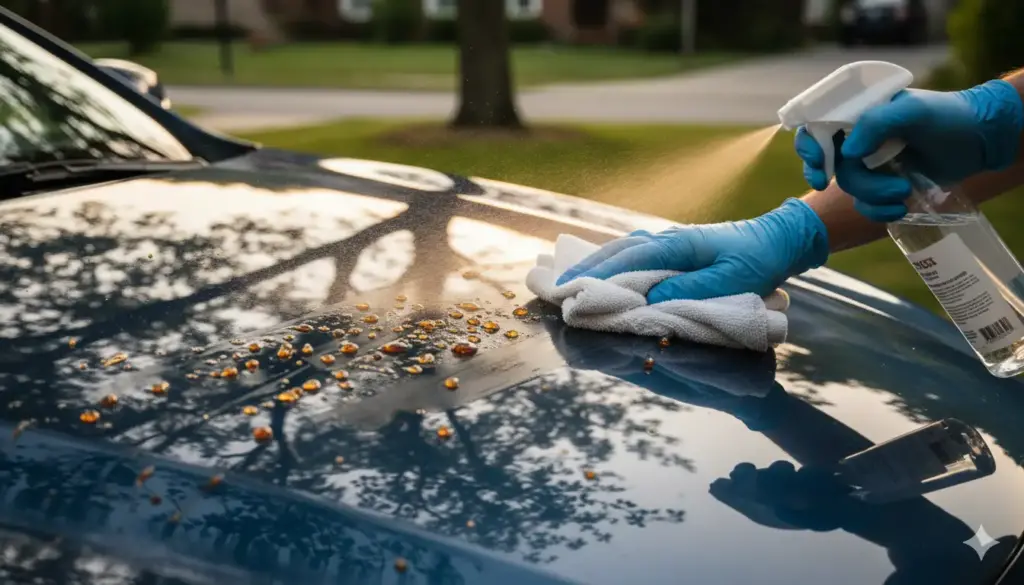
Key Takeaways
- Use isopropyl alcohol or commercial removers – never scrub hard or use abrasives
- Let solvents dissolve sap for 30-60 seconds before gentle wiping with microfiber
- Act quickly – damage begins within 1-2 weeks and becomes permanent after months
- Always wash and rewax after removal to restore paint protection
- Different surfaces require adapted methods – be gentler on plastic and fabric
- Prevention beats removal – avoid parking under trees and maintain wax protection
- Professional products worth the cost for stubborn or valuable vehicles
Next Steps
Act immediately when you notice tree sap on your vehicle – fresh sap removes easily while aged deposits risk permanent damage. Purchase isopropyl alcohol (70% concentration) or a dedicated automotive sap remover like Stoner Tarminator from your local auto parts store. Work in shade to prevent solvents from drying too quickly, and always have clean microfiber towels ready.
Start with the gentlest method first – rubbing alcohol on a microfiber cloth. If sap persists after two attempts, escalate to commercial bug and tar remover. For sap older than two weeks or baked on by sun, expect multiple applications and consider professional detailing if DIY methods fail. Remember that aggressive scrubbing causes more damage than the sap itself.
After successful removal, wash the entire vehicle to remove any solvent residue, then apply a fresh coat of quality car wax to the treated areas. This critical final step restores the protective barrier that prevents future sap adhesion and protects against environmental damage. Schedule monthly inspections during spring and summer sap season, and consider investing in ceramic coating or a fitted car cover if you must park near trees regularly.
For vintage or luxury vehicles, professional detailing may prove more economical than risking DIY damage. The $100-200 professional service cost pales compared to potential paint correction expenses reaching thousands. Document any paint damage from sap for insurance claims, as comprehensive coverage typically includes this type of environmental damage.
FAQs
What is the best and safest way to get tree sap off a car?
Apply isopropyl alcohol (70%) to a microfiber cloth, let it soak on the sap for 30-60 seconds to dissolve it, then gently wipe away without scrubbing hard.
Will rubbing alcohol (isopropyl) damage my car’s paint?
No, 70% isopropyl alcohol is safe when used properly on car paint. Always test on a hidden area first and rewax the area afterward to restore protection.
Can I use Goo Gone on my car to remove sap?
Yes, use only automotive-specific Goo Gone formula, apply sparingly to a cloth rather than directly on paint, and thoroughly wash and wax the area afterward.
How do you remove hardened (baked-on) tree sap?
Use commercial bug and tar remover, allow longer soaking time (2-3 minutes), apply gentle heat with hair dryer if needed, and expect multiple applications for complete removal.
Does WD-40 work to remove tree sap?
Yes, WD-40 effectively dissolves tree sap. Spray on sap, wait 5 minutes, wipe clean, then immediately wash the area with soap to remove petroleum residue.
Can I use hand sanitizer to get sap off my car?
Yes, alcohol-based hand sanitizer works well due to its 60-70% alcohol content. The gel formulation helps it stay in place for better sap penetration.
Will a regular car wash remove tree sap?
No, standard car washes rarely remove tree sap as they lack the targeted chemical action and dwell time needed. Manual removal with solvents is typically required first.
Does a clay bar remove tree sap?
Yes, detailing clay bars with proper lubricant can remove embedded sap after initial solvent treatment, but should not be the primary removal method.
How long can you leave tree sap on a car before it damages the paint?
Remove sap within days for best results. Sun-baked sap can begin etching clear coat within 1-2 weeks in hot weather, with permanent damage possible after 2-3 months.
How do I get tree sap off my windshield and windows?
Use rubbing alcohol, acetone, or commercial glass cleaner on glass surfaces. You can safely use a razor blade at a 45-degree angle on glass but never on painted surfaces.
Do I need to wax my car after removing tree sap?
Yes, sap removal strips away existing wax protection. Always reapply wax or sealant to the cleaned area to restore paint protection and prevent future sap adhesion.
References
- Car Detailing Studio. (2025). How to Remove Tree Sap from Car Without Damaging Paint. https://cardetailingstudionearme.com
- Westie’s Details. (2025). The Ultimate Guide to Removing Tree Sap from Your Car. https://www.westiesdetails.com
- Chemical Guys. (2025). How To Remove Tree Sap From Car. https://www.chemicalguys.com
- Dr. Beasley’s. (2019). IPA vs. Panel Wipes: Which Is Better at Removing Polish. https://www.drbeasleys.com
- Trojan Auto Care. (2024). Removing Tree Sap: Tips and Tricks for Car Owners. https://trojanautocare.com
- CarParts.com. (2024). Will Rubbing Alcohol Damage Car Paint? https://www.carparts.com
- High Def Detailing. (2021). How Tree Sap Can Damage Your Vehicle. https://www.highdefdetailing.com
- Consumer Reports. (2019). How to Get Tree Sap and Bugs Off Your Car. https://www.consumerreports.org
- KBB. (2025). Will Rubbing Alcohol Damage Car Paint? https://www.kbb.com

I am a senior automotive analyst at Autvex. Expert vehicle evaluations, in-depth reviews, and objective analysis helping readers make informed automotive decisions with years of industry experience.

